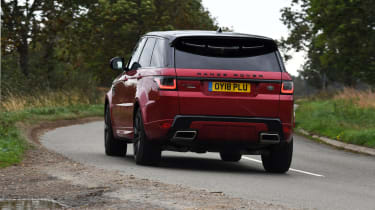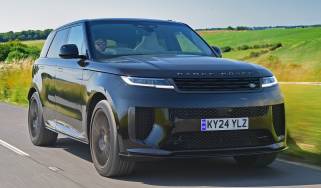Range Rover Sport SUV (2013-2022) - Engines, drive & performance
The Range Rover Sport is fast and handles well, but it’s still a big, heavy 4x4
The latest Range Rover Sport has made big leaps forward in driver enjoyment over the first generation. This is thanks in part to its lighter construction, which makes increased use of aluminium. The weight loss has led to a greater feeling of stability in corners than its predecessor.
As well as being relatively light for such a big SUV, the Range Rover Sport has a cleverly designed chassis. There’s an anti-roll system to keep the car level through corners and it works very effectively – while big SUVs usually lean quite markedly in bends, the Sport does it a lot less than you might expect.
There's no getting away from the fact that this is still a big, heavy SUV; you have to brake quite heavily to scrub off speed into corners and roundabouts, and in this respect it doesn’t wash off speed quite so effectively as a Porsche Cayenne Coupe. The steering feels quite precise and although it might seem a little too light, it probably wouldn’t instil as much confidence if it was heavier. As it is, you don’t feel that you have to wrestle the car through corners and it's impressive how the Sport seems to shrink around you on a country road.
Step up to the SVR and there's an immediate difference – and not just from the massive increase in power. Tweaks to the suspension mean the SVR doesn't point its nose in the air under heavy acceleration, nor does it dive when the brakes are applied hard. Its stiffened setup means even less body lean in corners, too, as well as a greater sense of confidence that this big, heavy SUV will go exactly where you point it.
More reviews
Car trim reviews
In-depth reviews
- Range Rover Sport review – comfortable and good to drive
- Range Rover Sport PHEV review
- Range Rover Sport PHEV SUV (2013-2022) review
- Range Rover Sport SUV review (2013-2022)
Road tests
Used car reviews
Land Rover is proud of the off-road credentials of its cars and no Sport is an exception. Away from the tarmac, it still has the advantage over its Audi Q7, BMW X6, Porsche Cayenne and Volvo XC90 rivals – with its huge range of driver-assistance modes, it’s every bit as capable as its larger Range Rover stablemate.
Every Range Rover Sport is fitted with Land Rover's super-smooth eight-speed automatic gearbox
Range Rover Sport petrol engines
The flagship of the Range Rover Sport range is the SVR, which uses a supercharged 5.0-litre V8 tuned to a formidable 567bhp. This is enough to thrust the car from 0-62mph in just 4.5 seconds, emitting a thunderous roar as it does so. It's remarkably responsive – the supercharger is always on call, with none of the delay that plagues some turbocharged cars, and it emits an appealing whine when full power is demanded. Given somewhere safe and legal to do so, you can take the SVR to an incredible top speed of 176mph.
Sitting in the middle of the Range Rover Sport range, the P400 uses a turbocharged 3.0-litre straight-six petrol engine and a 48-volt mild hybrid system for a total power output of 396bhp. It’s capable of 0-62mph in 5.9 seconds and a top speed of 140mph, making it faster than the P400e plug-in hybrid petrol, and the diesel models.
Diesel engines
There are three diesel engines on offer which all feature mild-hybrid technology. The entry-level 3.0-litre D250 produces 296bhp, and can take the Sport from 0-62mph in 8.5 seconds. Next up is the considerably costlier but more powerful D300, which uses a 297bhp version of the same engine, taking 7.3 seconds to go from 0-62mph. Above this the D350 increases power to 346bhp, dropping the 0-62mph time to 6.9 seconds.
Hybrid engines
If you don't want to sacrifice performance but want your Range Rover Sport to be as economical as possible, while also keeping down the cost of BiK company-car tax liability, there's the P400e. This uses a 2.0-litre turbocharged petrol engine with 296bhp and an electric motor for a combined 398bhp. When its plug-in battery pack is fully charged from a home supply or public charger, up to 31 miles of electric driving is possible. It's quick too, taking 6.7 seconds to hit 62mph from a standstill.













